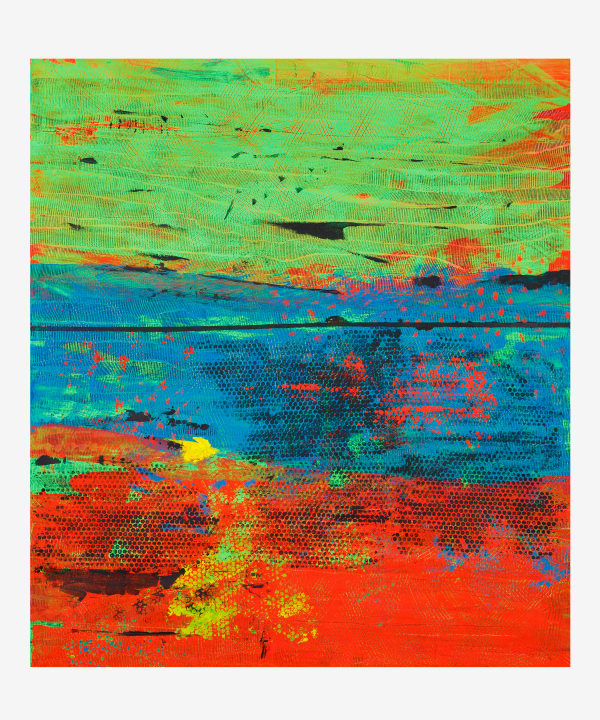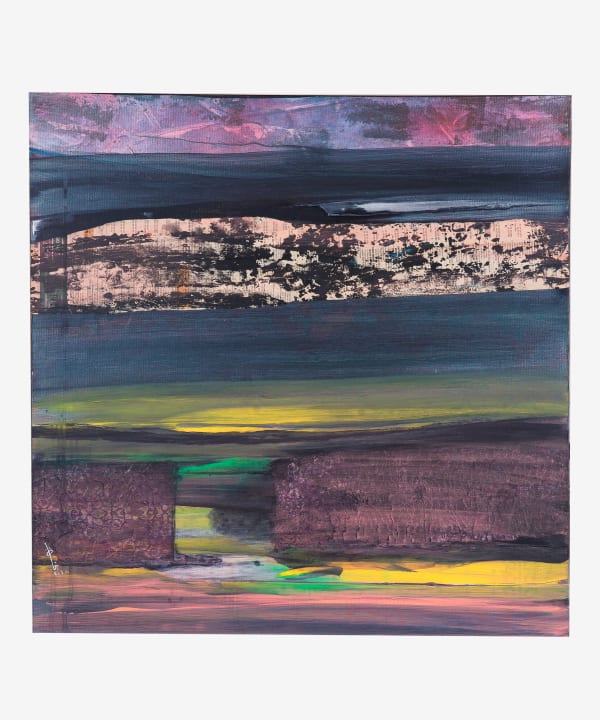-
Coming from one of the first pioneering generations of the UAE’s fine artists, along with contemporaries such as Hassan Sharif and Najat Makki, Abdulrahim Salim’s work both sketches and paints a distinct portrait of the nation’s cultural past, existing in dialogue with myth, folk tales, spirituality, and historical traditions of the Arabian Gulf. Particularly exploring the female form, figuration and abstraction slash together with equal harmony and dissonance in his Untitled Charcoal sketches on paper, for instance. Other charcoal works incorporate shocks of collage – a single scrap of scarlet paper – embedded into the image, such as in Untitled 112 (2019), like a cymbal clang in a song. It’s rather like the air is perennially smudged, as if in an incensed room, in the atmosphere of Salim’s artworks, nowhere more apparent than in his full-color paintings. Here, the scales are tipped further towards abstraction, where clear visuals appear as if slurried through a water tank, with clear figures or objects appearing more like shoals of fish in movement. Deep indigos, noirs, ruby reds, and jewel tones swim in and out of each other. The effect is mystical, resisting a transparent reading of meaning, more focused on capturing the textures and tints – the essence – of the meaning itself.
-
-
-
-
Salim began making art as a child of eight or nine in Bahrain, when school teachers noticed his lines and colors were simply better than his peers. After finishing secondary school, he returned home briefly to the UAE before departing for Egypt to study sculpture. Egypt, for Salim, was less of a place of learning than it was of discovery. Finding his studies unsatisfactory, he instead gathered inspiration in the museum. “A museum is like a book, a beautiful book of art,” he shares. “It’s a beautiful place for me, like when a child finds a shop of honey or sweets, chocolate or cake.” Looking at the exhibits and the people that perused them, Salim sketched and sketched. And when he completed his studies in Cairo, he came back to the UAE with the vigor to be different from, “not a copy”, of any other artist, unlike the bland roteness he had encountered in college. “So I read a book of magic,” he states, specifically the Ghazali book of magic. “It’s very big, a very difficult and very strange book,” he says, adding that he wanted his art to relate to and reflect that book. In his room, Salim began to practice the black magic rituals laid out in the text on his own, and later only stopped at the behest of his mother. The experience, however, wafted into his artistic style like clinging smoke.
-
-
Nowhere is her fascination with life-giving and nurturing aspects of nature more visible than in the female figures defiantly breaking up her swaths and strokes of color. Depicted in simple, abstract lines, mostly in profile and collectively gathered, Makki borrows from Ancient Egyptian relief carvings of female deities and mythological figures that embody tranquil stability, wisdom, strength and rebirth.
-
-
-
-
-
-
-
-
-

-
-
-
About the artist:
Press KitNajat Makki (b. Dubai, 1956) is a pioneering Emirati artist best known for her curiosity for color and dreamlike, abstracted depictions of the natural landscape in the UAE. What started as childlike wonder led her to Cairo, where she graduated with a Bachelor’s and Master’s degree in relief sculpture and metal from the College of Fine Arts (1982 and 1998, respectively). Upon returning to the UAE, the colorist and painter started exploring fluorescent paints through her work in scenography for children at the Ministry of Education, introducing the Gulf to a style of abstract painting that is characterized primarily by large fields of flat, solid color, spread across, creating areas of unbroken surface and a flat picture plane. Her use of this material in contemporary art contexts created an unconventional viewing experience, often accompanied by UV-A lights that elevate matter from canvas in lurid dimensionality. This experimentation was first debuted in her solo exhibition at Al Wasl Club in Dubai in 1987, marking a turning point in her career and gaining her regional recognition. Makki later returned to the Egyptian capital to pursue a doctorate degree, making her the first Emirati woman to formally specialize in the philosophy of art (2001), adding a theoretical dimension to her practical aptitude and visual flair.
Makki has exhibited widely in her home country but also internationally in Egypt, France, Germany, India, Jordan, Switzerland, Syria, Turkey and the United Kingdom. Her works are in the permanent collections of the Sharjah Art Museum, the Cultural Foundation in Abu Dhabi, Sultan Bin Ali Al Owais Cultural Foundation in Dubai, Women’s Museum in Dubai and the Ministry of Culture and Youth in Abu Dhabi, among many. Makki was the only female artist among the 15 showing at 1980 – Today: Exhibitions in the UAE, the National Pavilion UAE, the 56th Venice Biennale (2015) curated by Sheikha Hoor Al Qasimi, and had an acclaimed retrospective at the Cultural Foundation in Abu Dhabi entitled Luminescence (2019). She is a current member of the Dubai Cultural Council, the Emirates Plastic Arts Society and Art Friends Society. A multi-award-winning artist, she has received the Emirates Appreciation Award (2015), the Ministry of Culture, Youth and Community Development’s National Award for Arts, Sciences, and Literature (2008), Gulf Cooperation Council Biennial Award (1998), Sultan Bin Owais Cultural Award (1994), Jury Award, First session of Sharjah Biennial (1993), in addition to several excellence and merit certificates.
Najat Maki, 31 March - 5 September 2021
































